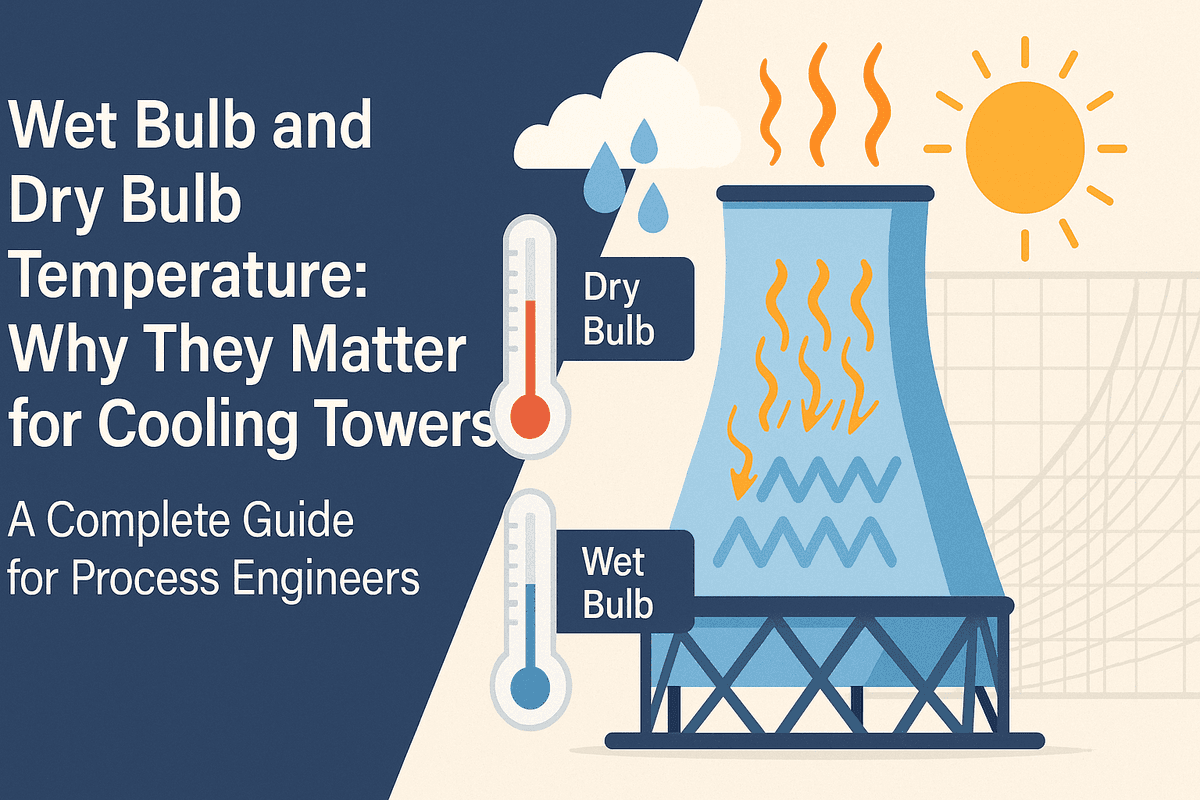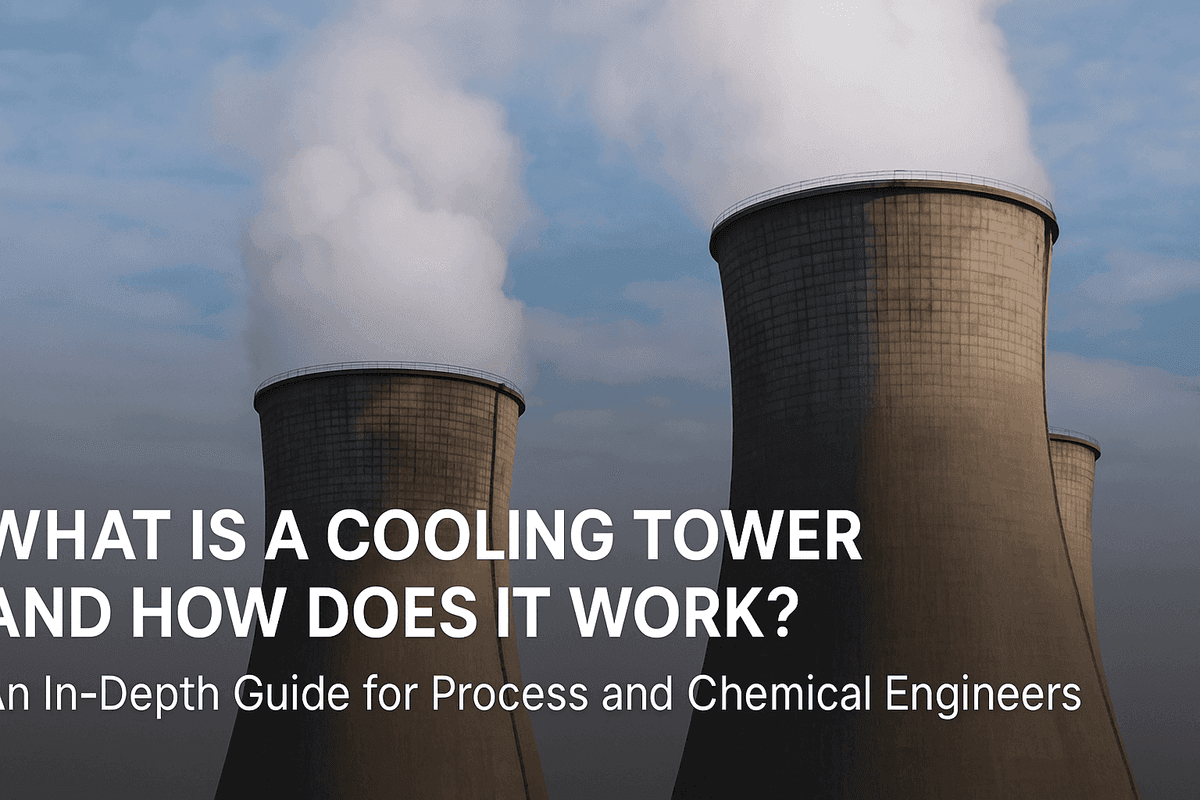Cooling Tower Efficiency: Formula, Psychrometric Principles, and Real-World Optimization

🌡️ Cooling Tower Efficiency: Formula, Psychrometric Principles, and Real-World Optimization
🧭 Introduction
Cooling towers are the unsung workhorses of industrial plants. They reject gigawatts of waste heat daily — from chemical reactors, gas turbines, and HVAC systems — using nothing but air and water.
Yet, 90% of operators cannot answer:
“What is my cooling tower’s true efficiency — and how do I improve it?”
This guide is your complete playbook for:
- Calculating real efficiency (not just textbook numbers)
- Using psychrometrics to predict performance
- Diagnosing hidden losses with field data
- Implementing low-cost upgrades that save 200K/year
- Leveraging digital tools and automation
🧮 1. The Real Cooling Tower Efficiency Formula
Forget the oversimplified version. True efficiency accounts for evaporation, drift, and air saturation.
Standard Efficiency (η_std)
But this ignores evaporation rate.
True Thermal Efficiency (η_true)
| Term | Meaning |
|---|---|
| Evaporation rate (kg/h) | |
| Latent heat of vaporization (~2450 kJ/kg) | |
| Enthalpy of saturated air at wet-bulb temp |
Reality Check: Most towers operate at 55–75% η_std, but only 40–60% η_true due to poor air utilization.
📊 2. Field Example: 5000 m³/h Cross-Flow Tower
| Parameter | Value |
|---|---|
| Water flow | 5000 m³/h |
| 43.2 °C | |
| 32.8 °C | |
| Ambient DB | 35 °C |
| Ambient WB | 28.5 °C |
| Air flow | 1,800,000 m³/h |
Step 1: Standard Efficiency
Step 2: True Heat Rejection
Step 3: Evaporation Rate
Step 4: True Efficiency
Using psychrometric chart:
, (oversaturated)
Insight: Your tower is only 58% thermally efficient despite 70% η_std.
🧠 3. Psychrometrics: The Hidden Driver
The Wet-Bulb Depression
- Dry climate (e.g., UAE summer): 12–15 °C → high potential
- Tropical (e.g., Singapore): 1–3 °C → low potential
Saturation Efficiency
- Target: > 85% for counter-flow
- Cross-flow: 70–80%
Pro Tip: Plot air path on psychrometric chart — if it doesn’t reach 95% RH, you’re losing capacity.
⚙️ 4. The 7 Key Performance KPIs
| KPI | Formula | Target | Impact if Off |
|---|---|---|---|
| Range | 8–12 °C | Too low → undersized chiller | |
| Approach | 3–5 °C | Too high → poor heat transfer | |
| L/G Ratio | 0.8–1.2 | Too high → flooding | |
| Evaporation Rate | 1–2% of circulation | High → makeup cost | |
| Drift Loss | Measured via tracer | < 0.005% | High → environmental fines |
| Merkel Number (KaV/L) | 1.0–2.0 | Low → poor fill performance | |
| Fan Efficiency | > 75% | Low → energy waste |
🔍 5. Root Causes of Low Efficiency (Field Data)
| Symptom | Root Cause | Fix Cost | ROI |
|---|---|---|---|
| Approach > 7 °C | Fouled fill (scale/biofilm) | $15K clean | 6 months |
| High ΔP across fill | Clogged nozzles | $2K flush | 1 month |
| Fan current < 80% FLA | Belt slip / VFD fault | $3K repair | 2 months |
| T_cold > T_wb + 6 °C | Low airflow | VFD tuning | 3 months |
| Make-up > 2.5% | Drift eliminator damage | $8K replace | 9 months |
🔧 6. 10 Proven Optimization Strategies
1. Install VFDs + Smart Control
- Modulate fan speed based on approach setpoint
- Savings: 30–50% fan power
- Payback: 12–18 months
2. Upgrade to High-Efficiency Fill
| Fill Type | KaV/L | Pressure Drop | Life |
|---|---|---|---|
| Splash | 0.8 | Low | 5 yrs |
| Film (PVC) | 1.5 | Medium | 10 yrs |
| Trickle (PP) | 2.2 | Low | 15+ yrs |
Case Study: 1000 RT tower → +2 °C range, -15% fan power
3. Automated Chemical Dosing
- ORP + conductivity control
- Prevents scaling and Legionella
- Reduces blowdown by 40%
4. Drift Eliminator Retrofit
- Cellular PVC → < 0.001% drift
- Saves 100 m³/day water in large towers
5. Infrared Thermography
- Scan fill for hot spots (fouling)
- Schedule predictive cleaning
📈 7. Digital Twin & Predictive Analytics
Build a Cooling Tower Digital Twin
# Python + CoolProp import CoolProp as CP def tower_efficiency(T_hot, T_cold, T_wb, RH): h_in = CP.HAPropsSI('H', 'T', T_db+273.15, 'P', 101325, 'R', RH/100) h_sat = CP.HAPropsSI('H', 'T', T_wb+273.15, 'P', 101325, 'R', 1.0) return (T_hot - T_cold) / (T_hot - T_wb) * 100
Predictive Maintenance
- Vibration sensors on fan → detect bearing wear 30 days early
- AI model predicts approach creep from weather + load
🧩 8. Tower Type Comparison (2025 Data)
| Type | η_std | Footprint | Maintenance | Best For |
|---|---|---|---|---|
| Natural Draft | 60–65% | Huge | Low | Power plants |
| Counter-Flow Induced | 75–85% | Medium | Medium | Refineries |
| Cross-Flow FRP | 65–75% | Small | High | Rooftop |
| Hybrid (Wet+Dry) | 70–80% | Large | Complex | Water-scarce |
🔬 9. Advanced Design: Merkel Number Method
For new tower sizing:
Use Chebyshev integration or CTI Toolkit for accuracy.
Rule of Thumb:
- KaV/L = 1.0 → standard fill
- KaV/L = 2.0 → high-performance trickle fill
⚡ 10. Energy-Cost Impact Calculator
| Parameter | Value |
|---|---|
| Tower duty | 200 MW |
| Efficiency gain | +5% |
| Chiller COP | 5.0 |
| Electricity cost | $0.08/kWh |
Annual Savings:
🛠️ 11. Maintenance Checklist (Print & Laminate)
- Check fan blade pitch (every 3 months)
- Inspect drift eliminators for gaps
- Measure approach vs design (daily)
- Clean strainers (weekly)
- Test water chemistry (TDS, pH, biocide)
- Verify VFD setpoint logic
- Log makeup & blowdown
📚 12. References & Standards
- CTI STD-201 – Thermal Performance Certification
- ASHRAE 90.1 – Energy Standard for Cooling Towers
- IAPWS-95 – Water/Steam Properties
- API 661 – Air-Cooled Exchangers (wet bulb design)
- Marley Technical Report: Fill Performance (2024)

